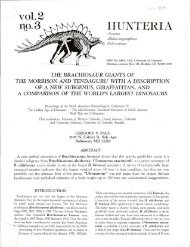THE MANY MYTHS, SOME OLD, SOME NEW, OF ... - Gregory S. Paul
THE MANY MYTHS, SOME OLD, SOME NEW, OF ... - Gregory S. Paul
THE MANY MYTHS, SOME OLD, SOME NEW, OF ... - Gregory S. Paul
You also want an ePaper? Increase the reach of your titles
YUMPU automatically turns print PDFs into web optimized ePapers that Google loves.
DINOSAUR <strong>MYTHS</strong> 95<br />
survived the many eatlier events in good order, with no indication of any substantial<br />
size and diversity-squeezes having occurred (<strong>Paul</strong>, 1988c).<br />
<strong>THE</strong> LAST DINOSAURS RESTED UNDER <strong>THE</strong> SHADE<br />
<strong>OF</strong> TALL HARDWOODS<br />
Myth: Because angiosperms were the most abundant large plants in the Late<br />
Cretaceous (Cenomanian-Maastrichtian), artists (including myself) have often<br />
included tall hardwood trees in their late Mesozoic landscapes.<br />
Reality: While large conifer logs are common in Mesozoic sediments, the diameter<br />
of angiosperm wood did not exceed 10 em until the Cenozoic (Crane, 1987). This<br />
means that Late Cretaceous dinosaurs lived in dwarf angiosperm woodlands and<br />
shrub lands where the.trees were only a few meters tall, a rather monotonous short<br />
stature flora broken only by isolated individuals and stands of towering conifers and<br />
other nonflowering trees.<br />
<strong>THE</strong>RE IS MORE THAN ONE WAY TO RESTORE A DINOSAUR<br />
Myth: At the end of a heated discussion, often I have heard the retort, "well, there is<br />
more than one way to restore a dinosaur!"<br />
Reality: A dubious statement at best, it is becoming less and less true as we learn<br />
more and more about the actual appearance of dinosaurs. After all, each taxa had a<br />
particular form and appearance in life, and in many cases we know what this form<br />
.was (<strong>Paul</strong>, 1987a). Hadrosaurs have down curved rather than straight anterior dorsal<br />
columns, soft dorsal frills are often preserved, and their skin is well documented. The<br />
knees of giant theropods, ornithopods, and ceratopsids articulated correctly only<br />
when they were flexed like those of birds, they did not have the straight knees of<br />
elephants (<strong>Paul</strong>, 1987a). Of course, there are many other things we do not know, and<br />
many areas remain open to dispute. Even so, I have noticed that the above statement<br />
is usually voiced when the speaker has run out of specific arguments for their case. So<br />
it contains little useful information, and it encourages the anything goes attitude that<br />
long plagued the field of paleorestoration.<br />
CONCLUSION<br />
At the best, some of the myths outlined above are hurtful to the science of<br />
dinosaurology because there is a good chance that they are wrong in part or in whole,<br />
and yet are widely accepted as fact without proper substantiation. Many others of the<br />
above myths are patently false, being contradicted by modern biology and other<br />
sciences. False concepts must be abandoned before we can better understand the<br />
true nature of dinosaurs and the world they lived in. For example, as long as it is<br />
believed that sauropods were dimwitted, weak herbivores unable to eat the few<br />
ounces per bite needed to sustain a high metabolic rate, and were in constant danger<br />
of overheating; -then it is hardly possible to see them as anything other than<br />
bradymetabolic reptiles. If on the other hand they are seen as social, fast growing;.<br />
tree wrecking herbivores of exceptional power, well able to take in and process<br />
fodder equalling 1 or 2% of their body mass per day that descended from tiny,









